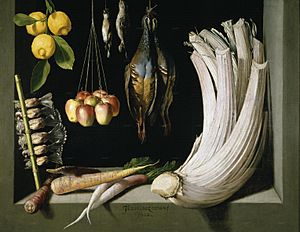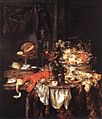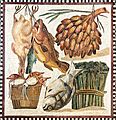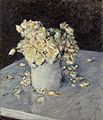Still life facts for kids
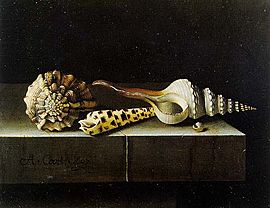

A still life (plural: still lifes) is a work of art depicting mostly inanimate subject matter, typically commonplace objects which are either natural (food, flowers, dead animals, plants, rocks, shells, etc.) or man-made (drinking glasses, books, vases, jewelry, coins, pipes, etc.).
With origins in the Middle Ages and Ancient Greco-Roman art, still-life painting emerged as a distinct genre and professional specialization in Western painting by the late 16th century, and has remained significant since then. One advantage of the still-life artform is that it allows an artist a lot of freedom to experiment with the arrangement of elements within a composition of a painting. Still life, as a particular genre, began with Netherlandish painting of the 16th and 17th centuries, and the English term still life derives from the Dutch word stilleven. Early still-life paintings, particularly before 1700, often contained religious and allegorical symbolism relating to the objects depicted. Later still-life works are produced with a variety of media and technology, such as found objects, photography, computer graphics, as well as video and sound.
Because of the use of plants and animals as a subject, the still-life category also shares commonalities with zoological and especially botanical illustration. However, with visual or fine art, the work is not intended merely to illustrate the subject correctly.
Still life occupied the lowest rung of the hierarchy of genres, but has been extremely popular with buyers. As well as the independent still-life subject, still-life painting encompasses other types of painting with prominent still-life elements, usually symbolic, and "images that rely on a multitude of still-life elements ostensibly to reproduce a 'slice of life'. The trompe-l'œil painting, which intends to deceive the viewer into thinking the scene is real, is a specialized type of still life, usually showing inanimate and relatively flat objects.
Images for kids
-
Edouard Manet, Carnations and Clematis in a Crystal Vase (1883)
-
Still life on a 2nd-century mosaic, with fish, poultry, dates and vegetables from the Vatican museum
-
Hans Memling (1430–1494), Vase of Flowers (1480), Museo Thyssen-Bornemisza, Madrid. According to some scholars the Vase of Flowers is filled with religious symbolism.
-
Jacopo da Empoli (Jacopo Chimenti), Still life (c. 1625)
-
Willem Kalf (1619–1693), oil on canvas, The J. Paul Getty Museum
-
Pieter Claesz (1597–1660), Still life with Musical Instruments (1623)
-
Jan Philip van Thielen (1618–1667), Vase of Flowers (c. 1660), Fitzwilliam Museum, Cambridge, England
-
Diego Velázquez, Old Woman Frying Eggs (1618), (National Gallery of Scotland), is one of the earliest examples of bodegón.
-
Francisco de Zurbarán, Bodegón or Still Life with Pottery Jars (1636), Museo del Prado, Madrid
-
Josefa de Ayala (Josefa de Óbidos), Still-life (c. 1679), Santarém, Municipal Library
-
Luis Meléndez (1716–1780), Still Life with Apples, Grapes, Melons, Bread, Jug and Bottle
-
Vincent van Gogh (1853–1890), Sunflowers or Vase with Fifteen Sunflowers (1888), National Gallery (London)
-
Jean Metzinger, Fruit and a Jug on a Table (1916), oil and sand on canvas, 115.9 x 81 cm, Museum of Fine Arts, Boston
-
Giorgio Morandi (1890–1964), Natura Morta (1956), oil on canvas, private collection
-
A completely synthetic, computer generated still life, 2006 (by Gilles Tran)
-
Jacopo de' Barbari, Still-Life with Partridge and Gauntlets (1504), a very early independent still life, perhaps the back or cover for a portrait
-
Joachim Beuckelaer (1533–1575), Kitchen scene, with Jesus in the house of Martha and Mary in the background (1566), 171 × 250 cm (67.3 × 98.4 in).
-
Annibale Carracci (1560–1609), Butcher's Shop (1580)
-
Michelangelo Merisi da Caravaggio, Fruitbasket (1595–96), oil on canvas, 31 x 47 cm
-
Juan Sánchez Cotán, Still Life with Game Fowl, Vegetables and Fruits (1602), Museo del Prado Madrid
-
Giovanni Ambrogio Figino, Metal Plate with Peaches and Vine Leaves (1591–94), panel, 21 x 30 cm, his only known still life
-
Cornelis Norbertus Gysbrechts (c. 1660–1683), Trompe l'oeil (c. 1680), Los Angeles County Museum of Art
-
Jan Philip van Thielen (1618–1667), Vase of Flowers (c. 1660), Fitzwilliam Museum, Cambridge, England]]
-
Maria van Oosterwijk, Vanitas-Still Life (1693)
-
Lubin Baugin (c. 1610-1663), Le Dessert de gaufrettes (c. 1631), Musée du Louvre, Paris
-
Willem Claeszoon Heda (1594–1680), Still Life with Pie, Silver Ewer and Crab (1658)
-
Pieter Claesz (c.1597–1660), Still Life (1623)
-
Jan Davidsz. de Heem (1606–1684), Still Life with Fruit, Flowers, Glasses and Lobster (c. 1660s)
-
Pieter Claesz (c. 1597–1660), Still Life with Salt Tub
-
George Flegel (1566–1638), Still-Life with Bread and Confectionery, 1630
-
Fede Galizia (1578–1630), Apples in a Dish (c. 1593)
-
Fede Galizia, (1578–1630), Maiolica Basket of Fruit (c. 1610), private collection
-
Giovanna Garzoni (1600–1670), Still Life with Bowl of Citrons (1640), tempera on vellum, Getty Museum, Pacific Palisades, Los Angeles, California
-
Jean-Baptiste-Siméon Chardin, Still Life with Glass Flask and Fruit (c. 1750)
-
Jean-Baptiste Oudry, The White Duck (1753), stolen from Houghton Hall in 1990
-
Rachel Ruysch, Roses, Convolvulus, Poppies, and Other Flowers in an Urn on a Stone Ledge (1680s)
-
Anne Vallayer-Coster, The Attributes of Music (c. 1770)
-
Anne Vallayer-Coster, Still Life With Lobster (c. 1781)
-
Anne Vallayer-Coster, The Attributes of Painting (c. 1769)
-
Francisco Goya, Still Life with Fruit, Bottles, Breads (1824–1826)
-
Eugène Delacroix, Still Life with Lobster and trophies of hunting and fishing (1826–1827), Louvre
-
Gustave Caillebotte, (1848–1894), Yellow Roses in a Vase (1882), Dallas Museum of Art
-
Henri Fantin-Latour, (1836–1904), White Roses, Chrysanthemums in a Vase, Peaches and Grapes on a Table with a White Tablecloth (1867)
-
Paul Cézanne (1839–1906), The Black Marble Clock (1869–1871), private collection
-
Mary Cassatt, (1844–1926), Lilacs in a Window (1880)
-
Claude Monet (1840–1926), Still-Life with Apples and Grapes (1880), Art Institute of Chicago
-
Paul Gauguin, Still Life with Apples, a Pear, and a Ceramic Portrait Jug (1889), Fogg Museum, Cambridge, Massachusetts
-
William Harnett (1848–1892), After the Hunt (1883)
-
William Harnett (1848–1892), Still life violin and music (1888), Metropolitan Museum of Art, New York City
-
[Darius Cobb]] (1834–1919), a Civil War trompe l'oeil composition, here in a chromolithograph print
-
Henri Matisse (1869–1954), Dishes and Fruit (1901), Hermitage Museum, St. Petersburg, Russia
-
Odilon Redon (1840–1916), Flowers (1903)
-
Georges Braque (1882–1963), Violin and Candlestick (1910), San Francisco Museum of Modern Art
-
Juan Gris (1887–1927), Nature morte (1913), Museo Thyssen Bornemisza
-
Marsden Hartley (1877–1943), Handsome Drinks (c. 1916), Brooklyn Museum
-
Fernand Léger (1881–1955), Still Life with a Beer Mug (1921), Tate
-
Pablo Picasso, Compotier avec fruits, violon et verre (1912)
-
Henri Matisse, Still Life with Geraniums (1910), Pinakothek der Moderne, Munich, Germany
See also
 In Spanish: Bodegón para niños
In Spanish: Bodegón para niños


